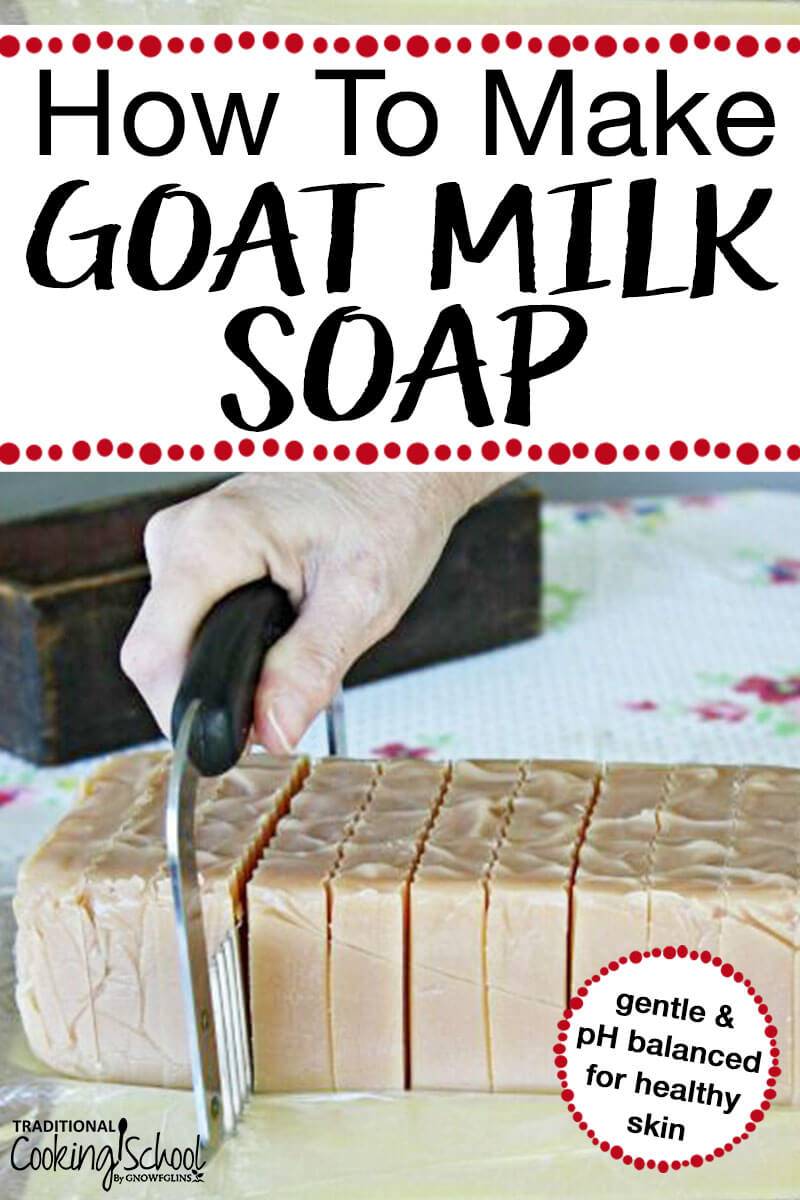
Do you know exactly what you’re putting on your largest organ — your skin?
The products we use on our bodies should be just as safe and clean as the food we put in our bodies!
And one of the best ways to ensure this is to make your own bath and body products. It’s easy to make your own deodorant, sunscreen, bug bite sticks, lotion bars, body butter, tooth powder and toothpaste, hair gel and hairspray, dry shampoo, and even soap — all at home!
Have I convinced you to give any of these a try, yet? 😉
I still remember what convinced me to make goat milk soap — bringing home our first 2 dairy goats! Their arrival sparked new ideas, dreams, and possibilities. Like what scent should my soap be? What about texture, like coffee grounds or oatmeal? What shape?
Thankfully, those type of decisions are the hardest part of the soap-making process. Although lye-based soap-making requires common sense and safety measures, it’s very easy to do!
Benefits Of Goat Milk Soap
First of all, goat milk soap is very gentle and pH balanced. So if you have dry or sensitive skin, acne, or eczema, this is the soap for you!
Additionally, if you already have healthy skin, goat milk soap will keep it that way.
However, if you don’t have access to goat milk, simply substitute an equal amount of water in place of the milk in this recipe.
Don’t Get Burned!
Lye (sodium hydroxide) is a caustic chemical that can cause severe burns. So, before making soap, you need the following safety equipment:
- rubber gloves
- safety goggles
- medical-type face mask
In addition to these items, pour and stir the lye solution slowly and carefully to avoid splashing. Work in a well-ventilated area, and educate any family or friends present about the dangers of lye.
Use only plastic, glass, or stainless steel containers when mixing the lye. And be sure to label them for soap-making purposes only!
Remember that the lye in soap is still active until saponification (the chemical reaction that makes soap) is complete. This can take up to 24 hours.
Finally, don’t be afraid — just be smart!
Gathering Your Supplies
You will need the following supplies. Items marked with an asterisk come into contact with lye, and should be used only for soap-making.
- frozen goat milk
- lye
- fats and oils (see recipe below)
- essential oils
- container to weigh lye crystals
- containers or bowls to weigh oils
- container in which to mix goat milk and lye (plastic, glass, or stainless steel)*
- spoon for mixing goat milk and lye (plastic, glass, or stainless steel)*
- stainless steel or enamel-coated pot for melting oils, and mixing lye + melted fats and oils together*
- long-handled whisk or immersion blender for mixing lye solution + melted fats and oils*
- kitchen scale
- 2 thermometers* (1 for measuring temperature of lye solution*, 1 for measuring temperature of fats and oils)
- rubber spatula*
- safety equipment: rubber gloves, safety goggles, mask*
- knife for cutting finished soap
- mold (wide, shallow box lined with grocery bag or wax paper; for round bars: 3-inch PVC pipe lined with parchment paper with a used canning seal at the bottom)
Let’s Saponify!
sa•pon•i•fy: v. -fied, -fy•ing.v.t.
1. to convert (a fat) into soap by treating with an alkali.
In other words, let’s put on those goggles, rubber gloves, and face masks! It’s time to make soap!
I developed the following recipe using the SoapCalc website. The end result? A hard, creamy bar of soap with good lather and cleansing properties.
All ingredients are measured by weight, not volume. Remember to place your container on the scale and tare it before measuring the ingredients.
This soap-making method is called “cold process”. The bars need to cure for 4 to 6 weeks before using.
Alternatively, “hot process” soap (like this) is cooked during saponification. This speeds up the process significantly, and means you can use the bars sooner. However, with hot process soap, you may lose some beneficial properties of essential oils due to adding them to a hot soap mixture.
Cold Process Goat Milk Soap
- 24.7 ounces frozen goat milk OR water (freeze milk in ice cube trays, then add cubes to scale until you reach the correct weight; do not freeze water)
- 6.7 ounces lye
- 18 ounces coconut oil
- 24 ounces lard
- 1 ounce castor oil
- 2 ounces olive oil
- 2 ounces essential oil(s) (optional; pick a single oil or a favorite combination!)
Prepare soap molds by lining with plastic, wax, or parchment paper.
Weigh out goat milk in designated milk/lye mixing container. Set aside. Weigh out lye crystals. Set aside. Weigh out essential oils. Set aside.
Weigh out coconut oil, lard, castor oil, and olive oil. Combine all in pot. Place pot over low heat until solid oils have melted completely. Remove from heat and set aside.
Then slowly pour lye into designated milk/lye mixing container. The milk will start melting right away. Carefully stir mixture until milk is melted. Once milk and lye solution is combined, place container in bowl of ice water so it can cool down. The milk and lye solution shouldn’t be hotter than the oils — it needs to be the same temperature or within 10 degrees Fahrenheit cooler.
Check the temperature of the melting oils. I aim for it to be about 100 degrees Fahrenheit, with the milk and lye solution about 90 degrees Fahrenheit.
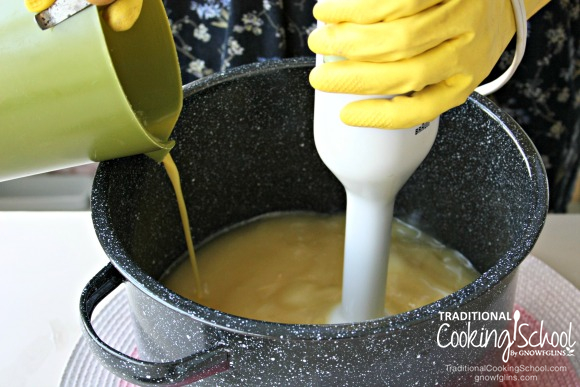
Once the milk and lye mixture is cool enough, carefully pour it into the pot with melted oils. Stir as you pour.
And then stir some more! Stir, and stir, and stir until the lye solution and oils are completely combined and reach “trace”. Trace is the point where the oils and lye are completely combined and can no longer separate again. Think of it as emulsification, like when making mayonnaise.
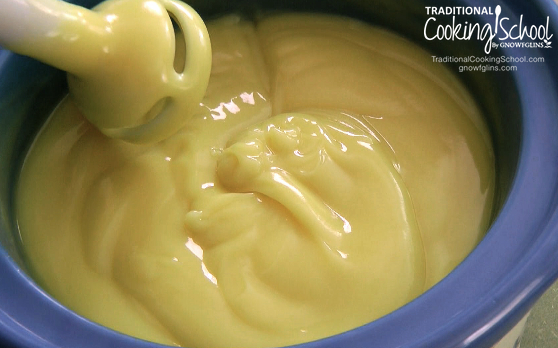
Test for trace periodically by pulling your whisk or immersion blender out of the mixture. Once it reaches trace, ridges and drips will form and won’t go back down. It should be thick like gravy.
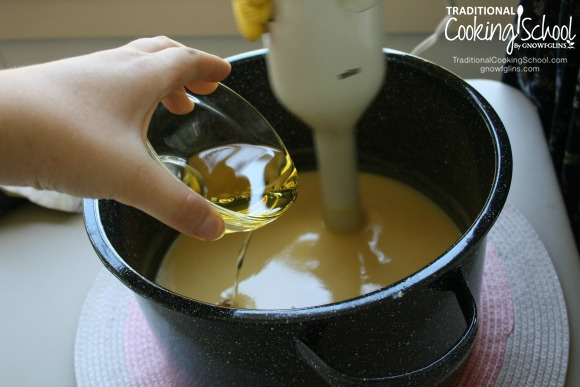
Once you reach trace, add any essential oils. Pour in and combine well. Check for trace again.
Then pour the mixture into soap molds, using a rubber spatula to smooth the top of your soap or create a nice texture. Keep in mind that the soap does not settle as it hardens.
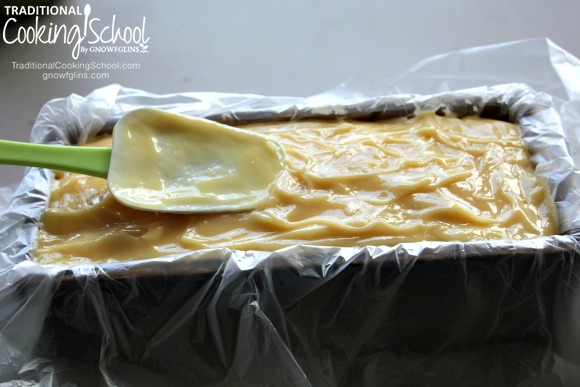
Finally, move soap to a cool, dark area and allow it to sit undisturbed for 24 to 48 hours. The lye can still be active for a while, so don’t touch the soap with your bare hands until 24 hours is up!
Washing Up & Curing Soap
Now, look at the mess you’ve made! 😉 Wash any equipment used only for milk, oils, or fats (the container used to measure, the spoon used to stir, and thermometer).
Anything used for the lye solution (container used to mix milk and lye, the spoon used to stir, thermometer, pot, whisk or immersion blender, spatula) should be placed together and allowed to sit for at least 24 hours before washing. When it’s safe to touch the soap, it’s safe to touch the utensils.
Once 24 to 48 hours passed, unmold and cut soap into bars so it can finish curing. Simply flip the soap out of the mold, and peel away the plastic lining. Cut it using a knife, fishing line, dental floss, or a crinkle cutter.

The bars of soap need to continue hardening and curing for another 4 to 6 weeks before use. Store the bars in a box, not touching each other so there is plenty of air flow. Flip and rotate the bars every few days so that all sides are exposed to the air periodically. Some people prefer to loosely cover the soap with a towel or lid, too.
When soap is hardened and cured, it’s ready to use! Put a bar by each sink, or wrap some up and give it to a friend. Enjoy the soft, creamy lather and wonderful scent — along with the satisfaction of a job well done! You now know exactly what you’re putting on your skin!
Have you ever made goat milk soap before? Will you give it a try?
...without giving up the foods you love or spending all day in the kitchen!

2 free books:
Eat God's Way
Ditch the Standard American Diet, get healthier & happier, and save money on groceries...
We only recommend products and services we wholeheartedly endorse. This post may contain special links through which we earn a small commission if you make a purchase (though your price is the same).


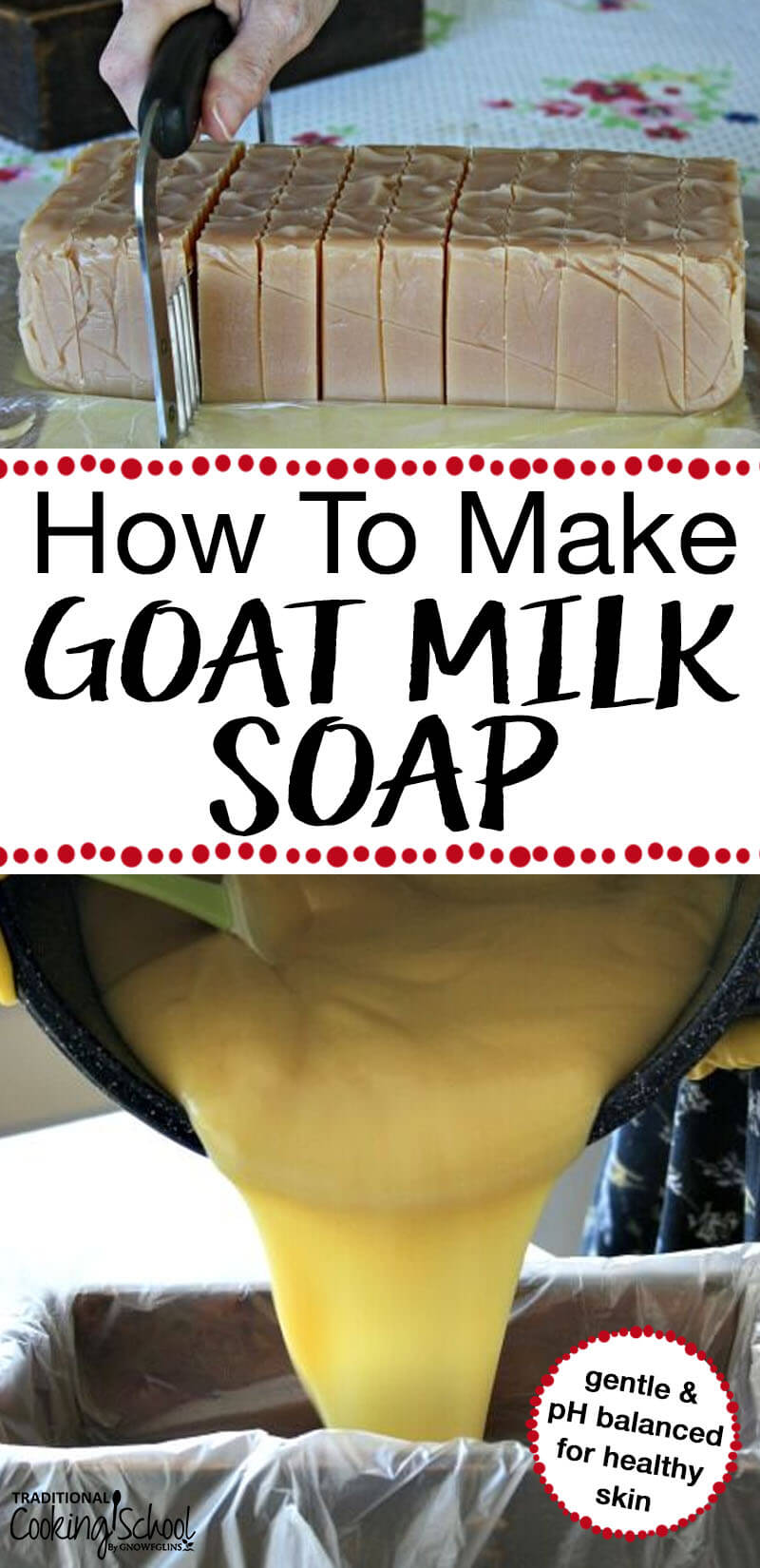
Thanks so much, Lindsey. You’ve taken all the guesswork out with your great instructions and I’m moving this up on my priority list of things to try!
You’re welcome! Let me know how it works out for you. 🙂
What can be substituted for lard in the goat milk soap? Also can you use powdered goat milk instead? Thank you, bonnie
i would like to know the same thing?? can you substitue any oil..for the castor oil and lard??
Can you use powdered Goats milk, and why must you freeze the milk?
You can substitute other oils but you MUST run it through the SoapCalc first as each oil requires a different amount of lye to saponify. If you don’t adjust you could end up with a lye heavy soap or your oils may not all saponify. Also each oil will give your soap a different characteristic. Such as, one oil may help with hardness of the bar, another may give you better lather. The reason for using frozen goat milk is milk and sugars such as honey will darken your soap due to the heat generated by the lye reaction but it can also scorch the milk causing it to smell bad. By using frozen milk the reaction of the lye stays cooler preventing scorching. Ask me how I know, my first batch made 20 years ago smelled so bad I threw it out!
Thank you so much for such a detailed lay-out of how to make bars of soap! I did this with a friend about a year ago, and the soap worked beautifully with our sensitive skin. 🙂 I’ve wanted to make it again, but her schedule and mine have conflicted, so maybe I’ll try to make this myself using your directions.
One question: using your sources for supplies, how much do you think it cost per bar of soap?
I ask because my friend last summer actually wanted to GIVE me the entire batch of soap, so I received a year’s worth of soap for nothing! Wow. Sure beats Dr. Bronner’s price in the stores. 🙂
I did buy three bars of naturally saponified soap online a few weeks ago, made in Greece, and each large 8 oz. bar was only about $2.60, so I’m wondering if I’d actually save $ making my own bars of soap like you’ve done.
You’re welcome! I hope you’re able to try making it soon.
As for the price, I estimate it would cost you about $1 per 3oz bar, so that’s pretty comparable to what you paid. 🙂
Can store bought goat’s milk (in the refrigerated section) be used for this? I do not have access to fresh goat’s milk.
Yep! I even know someone who makes it with reconstituted dried goat’s milk. 🙂
Can you use cow’s milk in place of the goat’s milk?
We’ve never tried it, but I think it would work. You might want to run this recipe through SoapCalc.net with cow’s milk instead of goat’s milk to see if it changes anything or suggests something different. Alternately, here’s a recipe that says you can use either goat’s or cow’s milk: http://hoeggerfarmyard.com/simple-milk-soap-recipe/
Hi there, just wondering why you freeze the milk and if it would be fine to use fresh unfrozen milk?
thanks.
Good question! We use frozen milk for two reasons – because the lye heats up the milk, it takes less time to cool to the correct temperature if you start with frozen milk. Also, because the milk turns brown as it heats up, using frozen milk means you get more of a creamy colored bar than a brown one. You certainly can use fresh unfrozen milk though! 🙂
Adding lye to fresh (unfrozen) milk will likely cause almost instant curdling due to the high heat. Then both the lye and milk will be wasted. Unfortunately, I do have first-hand experience with this. 😉
I didn’t use frozen milk so if you want to prevent this, put the mixing container in ice cubes and then add the lye and mix. It keeps it cool and also speeds up the process of the cooling of the lye mixture.
I have never mad soap. I would like to. This looks like a fun recipe and I have some goat’s milk from our goats. I have just been fraud to make it with small children are line.
Do you have any tips for that? Is it safe to make in the house with little ones around?
I wouldn’t make when small children are in the room, unless they were agreeable to wearing face masks and stayed well away from your work area.
Lindsey,
That’s a lot of essential oil. I looked up the eBay seller’s link and it comes to $25 for 2 oz. Just double checking on the amount needed. Could one get away with using 1 oz instead of two? I was thinking of lavender or vanilla.
Thank you for this tutorial. I think I’m getting closer to trying it.
Did you follow the link I included in this post? Right now, they have 8 oz of Rosemary Essential Oil for $10.90 (http://www.ebay.com/itm/8-oz-ROSEMARY-100-PURE-ESSENTIAL-OIL-DISPENSER-TOP-/190433127817?pt=LH_DefaultDomain_0&hash=item2c56b2ed89) and 8 oz of Vanilla Essential Oil for $15.49. (http://www.ebay.com/itm/8-oz-VANILLA-100-PURE-ESSENTIAL-OIL-SHIPPING-DEAL-/200372626531?pt=LH_DefaultDomain_0&hash=item2ea723a463)
Of course there’s shipping, (and they offer a combined shipping deal) but I don’t think adding that will make it come out to $25 for two ounces. 🙂
When I used your link for the vanilla it was over $30 for the 8 oz
Hi I was wondering if the lard could be substituted?
You can! But I would recommend using the calculator here at SoapCalc.net (http://www.soapcalc.net/calc/SoapCalcWP.asp) to re-calculate the recipe using whatever fat you plan on substituting. Lard helps with the hardness and conditioning of the soap, so I’d try to use something with comparable numbers. 🙂
I’ve been making soap for over 15 years. I started making it with my mother while still living at home and now make it with my husband. I’m anxious to try this recipe! 🙂
Thank you for posting. Great step by step pics. Would this recipe work with cows milk instead of goat?
Natalie, I’ve never made it with cow’s milk, but I don’t see why it wouldn’t work. You might want to run this recipe through the tool at SoapCalc.net with cow’s milk instead of goat’s milk to see if it changes anything or suggests something different. Alternately, here’s a recipe that says you can use either goat’s or cow’s milk: http://hoeggerfarmyard.com/simple-milk-soap-recipe/
If you try it, let me know how it turns out!
Do you sell your soaps online? If so, website link. prices, scents. thanking you in advance.
Not yet… 🙁 We hope to some day soon though!
I am not sure about this. I didn’t read everything, quite honestly once I say the word: LYE, I got turned off more. The first thing that left me pessimistic was the “drain opener”?
Now how organic is that? As well as the lye?
OK, Needless to say I am ignorant when it comes to lye. Quite frankly I would LOVE SO MUCH to make soap for myself, and why not? I already made a pleasing scented body lotion. I have made an eye cream, but the more I read about other ingredient’s I could use, I look forward to making a new improved lotion for my mature skin.
So enlighten me if you have the time and would be so kind 😉
Thanks in advance,
Cathy
That’s a great question and a valid point, Cathy!
First, let’s talk about lye. Lye is, in its simplest form, just the results of rainwater dripping through wood ashes. In fact, you can make it at home if you have the right type of wood and some rainwater or softened water – there are many tutorial on the internet telling how to do this, but this one has a lot of information, including how to test the strength of the lye. http://www.countryfarm-lifestyles.com/make-lye.html
I didn’t know how commercial lye is made, and I tried to do some research but got lost in the technical scientific jargon! Best I can tell, it’s made by electrolysis of a salt water solution, but beyond that, I don’t know exactly how. Chemistry was never my strong point!
As I understand it, the saponification process, which is an acid(the fats)/base(the lye) reaction, changes the chemical makeup and produces glycerin and a salt, which is your soap.
With regards to drain cleaner – yes, lye is used as a drain cleaner because it is caustic in its pure form. However, many drain cleaners are “lye based” and have other ingredients added, so if you decide to try making your own lye-based soap, make sure that whatever you’re getting is pure lye. 🙂
I hope that’s helpful!
thank you for this, it seems to be the most detailed how to i have come accross for goats milk soap.
i need unfragranced for my skin so i will leave out the essential oils but i do like goats milk soap with oats and honey in, would 2 ounces of that work instead?
thank you
I would say to use 2 ounces of honey instead of 2 ounces of essential oil, and then add the oats because they’re more for exfoliation and won’t really change the chemistry of the soap. It’s recommended to add the honey after trace so it doesn’t burn. 🙂 You can double-check the recipe by running it through the calculator at soapcalc.net – put in this recipe with honey instead of essential oils. 🙂
What size is the mold that you used? I have seen molds that hold either 4 or 6 lb. But I am not sure which size to use for this recipe. Thanks for your help, this is a great tutorial!
This recipe makes about 6 lbs of soap. We don’t have specific molds – just the box and PVC pipe shown in the picture – but the total yield is around 6 lbs.
Hi,
I realize this is a older blog. Hope it finds you.
What size mold are you using? Or maybe I should ask how many pounds of soap does this make?
James
Never mind should have reads further.
James
Hi,
Can you use other oils than olive? Like Palm? Sunflower?
James
Hi James!
You sure can, I just recommend inputting this recipe into the calculator at soapcalc.net with whatever oil you want to use in place of the olive to double check the lye amounts. 🙂
I am a little Leary of using PVC for milk soap. When I make goat milk soap I usually put it in the freezer for a few hours. I can’t get the PVC in my freezer, upright. Have you had any experience with this?
I’m sorry it took me so long to respond, Linda – somehow I missed the last few comments on here!
We don’t put the soap in the freezer at all – just let it sit in a cool, dark spot until it’s saponified. We do line the PVC with waxed paper, and we’ve never had any issues with it. 🙂
I’m trying to start a business with goat soap, lotions, shaving creams and such. Do you have any other recipe for these?? Also, where do you purchase your coconut oils and such??? Thank you!!!
Hi Hanna!
As of now, we only make soap, and this is the only recipe we use. We purchase our essential oils from the eBay store I linked to in the post, and we get our coconut and other oils from a discount grocery store near us. They don’t always have coconut, so if they don’t, we purchase it online from the Bulk Apothecary store. Hope that helps!
Hi Lindsey! Thanks for the great tutorial! We made the soap this afternoon and all went well, but I have a question about the essential oils.
We chose to leave them out all together because the only oils I had were small bottles of very expensive, organic, therapeutic oils that we use medicinally. The recipe would have taken 2 full bottles of our stock & I was just too cheap to do it ;). So, since the EOs are added after trace and are optional, why was it necessary for the total to be 2 oz.? I had thought about adding a smaller amount, but didn’t want to waste the EOs if the strength would be too weak. Hope that all makes sense!
Thanks so much for the info!!
Hello AJ! I’m glad you were able to follow the tutorial and that all went well for you!
The main purpose of the essential oils are for scenting purposes, so no, you don’t *have* to use the whole 2 oz. That amount, plus ensuring that the scents you mix contain one middle and/or base scent and not all top scents, just ensures your scent lasts longer. The formula for this “staying power” is 1/2 oz EO per lb of soap. So certainly you could use less EO, but the soap might not be as strongly scented when it’s finished curing, or the scent might not last as long as it would otherwise.
The amount we use is one reason we get our soapmaking oils from the eBay store rather than use the ones we get for health purposes.
I’ve just bought my first bar of handmade goat’s milk soap. I have allergy skin issues and I’m hoping it will give some relief. It’s a 7.5 oz. Bar and I’m looking for a way to store it while I use it. I bought it just for my face & neck. I’m usually back and forth between my house, my mom’s & my boyfriends, so it goes with me in my ”nessesity” bag. What should I do?
Make sure the bar is dried out well before you put it in your soap case/bag. Since most soap dishes aren’t that great for drainage, we use a small plate with 5 or 6 smooth river rocks spread out on it, and then place the bar of soap on top of that. The rocks keep the soap off the dish and out of any water that drips off, and as long as you keep some spaces between the rocks, the air circulates well.
Can I use the lard they sell in tubs at the grocery store? We buy pastured lard everyone in a while for cooking as it is so healthy. But is is so expensive! It would break my heart to use it for soap especially since this would be my first attempt and I am afraid I might mess up.
Find a butcher and purchase some pork fat. There are two kinds, but I won’t bother you with that because I just use it all and don’t bother with separating it. There are all kinds of tutorials on rendering fat, that’s where I learned to do it. I rendered about five lbs. a few years back and still have some frozen in canning jars in the freezer. The butcher we use is Amish and I don’t have to worry about a lot of hormones, etc. that way. I think I paid about 50¢/ lb. for the fat.
I made 3 batches of goat soap this past fall and it turned out good/ but you gave some good tips and the recipe a little different . I will try this one . I gave as gifts for Christmas and everyone liked . I use my goat soap exclusively- love it . Last a long time too.
I am looking for a goat lotion recipe. I tried one but it was too runny and separated with oil on top and spoiled easily! Do you have a lotion recipe using goat’s milk?
Thanks
Thank you for sharing, great tutorial!
Hello Lindsey Proctor, I just want to say that i love this recipe first of all. I am new to soap making and i am planing on making my first batch soon but i have a few questions. I was thinking about adding ground oatmeal as an exfoliate agent and use lavender oil, would it be okay if i just add it to the finished mixture of soap? Also, i buy a mint and patchouli goats milk soap for my self and my daughter and i was thinking of making it at home, do you have an y recipe for that?
Thanks in advance for your time!
I bought canned evaporated goats milk (it was all they had in the grocery store). Will this work the same or do I need to add water to it?
What do you do when the lye doesn’t heat up enough after pouring on frozen goats milk.
I had that happen and put the bowl into a sink with warm water to heat it up to within 10° of the oils. Mixed it at about 90°. Most beautiful cream colored soap I had ever seen. Put my PVC molds into the empty sink (thank goodness) and filled them. Went to take them out of the sink and the bottom came out. All that beautiful soap down the drain, literally. Fortunately, I had some left in the pan that didn’t fit into the mold that I poured into a silicone mold and I saved three bars worth. I’m ready to get another batch made as those three bars were amazing. I will say that EVERY recipe I’ve ever made, I ALWAYS run through a lot calculator. When it comes to lye, I never take any chances.
Hey Lindsey,
I want to make this soap. I’ve been looking for a recipe and this is the one I want to try. Thank you so much for sharing.
I have one question. Where did you get your scale? Do you have a link? Or could you give me the name. Someone told me you need a good scale for precise measurements.
Thank you again for sharing!
Mine is simply a digital food scale that weighs out either grams, ounces or pounds. I would search Amazon and I’m sure many will pop up, or I believe I purchased mine at Bed, Bath and Beyond.
Hello- I was wondering if you need to let goats milk soap cure for 4weeks if I use the goats milk base. It sets within a couple hours- in my cold garage. But wondering if I am doing something wrong. Thanks!
I’m allergic to coconut, is there a substitute? I can’t find a soap recipe without it.
Can this be done without using lye or any chemicals, just pure natural soap?
It is pure natural soap! Read the labels of some of the soap you use. They are processes/made using Lye. Ie: sodium palmate, sodium cocoate.
Can this goats milk soap be used as a melt and pour soap base for sugar scrub bars and other soaps? I don’t want to buy melt and pour soap bases because I’m not sure what’s in them, and that defeats the purpose of homemade soaps etc.
Great instructions too!
I really want to try to make this but the whole Lye thing has me unsure. Is it safe for me to use my kitchen inside the house? Would I need to open windows if I did?
Question! I made this recipe yesterday as specified. Weighed everything out to a T and my lye/milk mixture did not get that hot. It melt the ice cubes well enough but then just stayed around 70ish degrees. Any thoughts? Was it the type of lye I used maybe?
Here’s the lye I used: https://www.amazon.com/ComStar-024924305003-Drain-Opener-White/dp/B00PKNBK24/ref=sr_1_4?keywords=lye&qid=1558545114&s=gateway&sr=8-4
Can this be used as a shampoo bar?
Love this recipe and I’m excited to try it. Do you think I could do this the hot process method? I have done cold but im too impatient to wait weeks for curing! Thank you so much!
How could I incorporate some ground herbs (herbal powders) into this recipe?
What about condensed goat’s milk?
So what if your soap doesn’t reach trace? What should I do with it?
Want to try your recipe with Calendula infused oils. Would I do anything different?